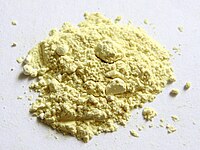Bismuth (III) oxide
| Crystal structure | |||||||||||||||||||
|---|---|---|---|---|---|---|---|---|---|---|---|---|---|---|---|---|---|---|---|

|
|||||||||||||||||||
| __ Bi 3+ __ O 2− | |||||||||||||||||||
| General | |||||||||||||||||||
| Surname | Bismuth (III) oxide | ||||||||||||||||||
| other names |
|
||||||||||||||||||
| Ratio formula | Bi 2 O 3 | ||||||||||||||||||
| Brief description |
light yellow, odorless solid |
||||||||||||||||||
| External identifiers / databases | |||||||||||||||||||
|
|||||||||||||||||||
| properties | |||||||||||||||||||
| Molar mass | 465.959 g mol −1 | ||||||||||||||||||
| Physical state |
firmly |
||||||||||||||||||
| density |
8.93 g cm −3 |
||||||||||||||||||
| Melting point |
817 ° C |
||||||||||||||||||
| boiling point |
1890 ° C |
||||||||||||||||||
| solubility |
practically insoluble in water |
||||||||||||||||||
| safety instructions | |||||||||||||||||||
|
|||||||||||||||||||
| Toxicological data | |||||||||||||||||||
| As far as possible and customary, SI units are used. Unless otherwise noted, the data given apply to standard conditions . | |||||||||||||||||||
Bismuth (III) oxide is a chemical compound (an oxide ) made up of bismuth and oxygen . It is the most important bismuth compound used industrially.
Occurrence
Of course, bismuth (III) oxide occurs in the mineral bismite (bismuth ocher), but is usually obtained as a by-product in the smelting of copper , tin and lead ores .
Extraction and presentation
Bismuth (III) oxide can be obtained by burning bismuth.
Analytically pure bismuth (III) oxide is obtained by heating the purest bismuth (III) nitrate pentahydrate up to 700 ° C.
properties
Physical Properties
Bismuth (III) oxide occurs in four different crystal structures (α-δ), of which the monoclinic α variant is present at room temperature .
Chemical properties
Bismuth (III) oxide is insoluble in water and the usual organic solvents, but soluble in acids that are not too dilute and in strong concentrated alkalis with the addition of glycerine. Bismuth (III) oxide easily forms solid solutions with other metal oxides , so molten bismuth (III) oxide dissolves every metal oxide and even corrodes platinum .
Bismuth (III) oxide reacts with hydrochloric or hydrofluoric acid to form bismuth (III) chloride or bismuth (III) fluoride .
use
Bismuth (III) oxide is used:
- As a starting material for the production of bismuth (reduction of bismuth (III) oxide with coal)
- As a chemical for fireworks
- In solid oxide fuel cells
- In glasses
- As a catalyst in the ceramic industry
- As a medicinal substance for the eradication of Helicobacter pylori
See also
- Bismuth (III, V) oxide Bi 4 O 7
- Bismuth (V) oxide Bi 2 O 5
literature
- Römpp Chemie Lexikon (9.), p. 439.
Individual evidence
- ↑ a b c d e f g h Entry on bismuth (III) oxide in the GESTIS substance database of the IFA , accessed on December 19, 2019(JavaScript required) .
- ↑ Bismuth (III) oxide data sheet (PDF) from Fisher Scientific , accessed on February 13, 2014.
- ↑ a b Georg Brauer (Ed.), With the collaboration of Marianne Baudler u a .: Handbook of Preparative Inorganic Chemistry. 3rd, revised edition. Volume I, Ferdinand Enke, Stuttgart 1975, ISBN 3-432-02328-6 , p. 601.





